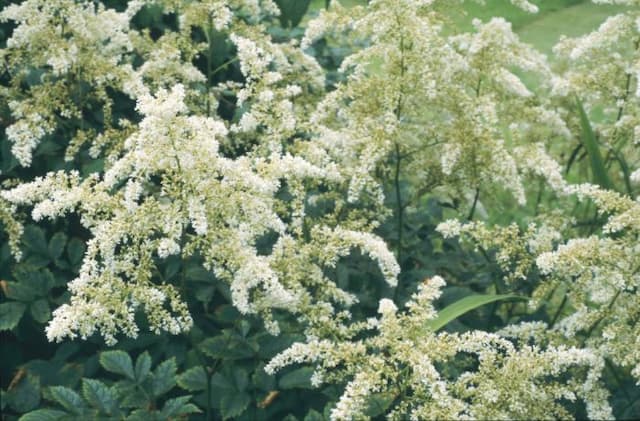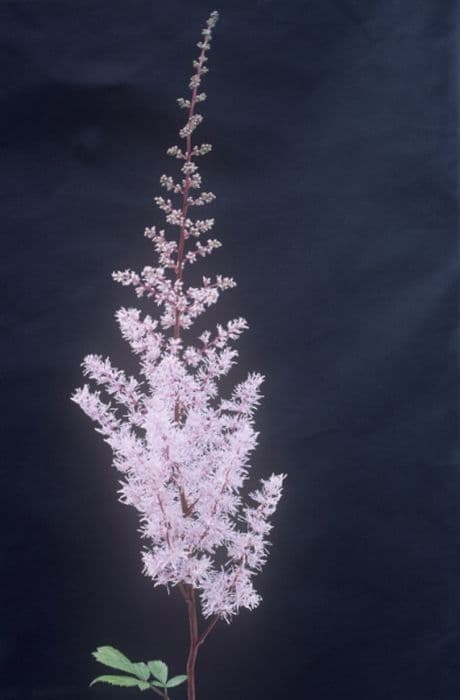Astilbe chinensis 'Milk and Honey' (PBR)

ABOUT
The Astilbe chinensis 'Milk and Honey', commonly referred to simply as Astilbe, is a perennial flowering plant that boasts an attractive and striking appearance. It features a lush mound of deeply dissected, fern-like foliage that often carries a rich, dark green color with an underlying hint of bronze. The leaves create a dense and feathery backdrop for the plant's most captivating attribute, its blooms. The flowers of 'Milk and Honey' are borne on upright, plume-like panicles that gracefully arch above the foliage. These flower plumes have a soft and frothy texture, appearing in a delicate shade of creamy white when they first open. As the blooms mature, they transform into a pale honey shade, giving them a two-toned effect that is both subtle and stunning. The transition from milk-white to honey-hued blossoms occurs over the blooming period, adding dynamism to the garden as the colors gently shift. The bloom time is typically in the summer months, creating a refreshing sight during the warm season. The contrast between the dark green leaves and the light, airy flowers makes the 'Milk and Honey' a sought-after variety for creating a serene and attractive garden setting. The plant's overall appearance is one of elegance and refinement, and it adds a touch of whimsy to the landscape. Ideal for borders and woodland garden settings, the Astilbe 'Milk and Honey' is a mesmerizing plant that evokes a sense of calm and beauty. Its ability to attract butterflies adds an additional layer of life and movement to its surroundings, enhancing the natural ambiance wherever it is planted.
About this plant
 Names
NamesFamily
Saxifragaceae
Synonyms
Chinese Astilbe, False Goat's Beard, False Spirea
Common names
Astilbe chinensis 'Milk and Honey' (PBR)
 Toxicity
ToxicityTo humans
Astilbe, also known as false goat's beard or false spirea, is not known to be toxic to humans. There is no significant evidence indicating that ingestion of any part of the Astilbe plant typically causes poisoning or adverse health effects in humans.
To pets
Similar to its effect on humans, Astilbe is generally considered non-toxic to pets, including dogs and cats. Ingesting parts of this plant is unlikely to cause poisoning or show symptoms of toxicity in pets. However, it's always prudent to monitor pets if they consume any plants, as individual reactions can vary.
 Characteristics
CharacteristicsLife cycle
Perennials
Foliage type
Deciduous
Color of leaves
Green
Flower color
White
Height
2 feet (60 cm)
Spread
2 feet (60 cm)
Plant type
Herb
Hardiness zones
4
Native area
China
Benefits
 General Benefits
General Benefits- Aesthetic Appeal: Astilbe chinensis 'Milk and Honey' features elegant, creamy white to pale pink plumes which add a delicate contrast to the garden space.
- Attracts Pollinators: Its blooms attract beneficial insects such as butterflies and bees, which are vital for pollination in the garden.
- Shade Tolerance: This variety of Astilbe is well-suited for shaded areas where many other flowering plants may struggle to thrive.
- Low Maintenance: Once established, it requires minimal care, making it an ideal choice for both novice and expert gardeners.
- Deer and Rabbit Resistant: The plant is generally not favored by deer and rabbits, reducing the risk of damage from these animals.
- Long Blooming Period: With a lengthy bloom time from mid to late summer, it provides extended visual interest in the garden or landscape.
- Moisture Indicator: Astilbes prefer moist soils, and their appearance can help gardeners gauge if the area is adequately watered or needs additional moisture.
- Soil Erosion Control: This plant's root system helps to stabilize soil and prevent erosion, especially in moist, shaded areas.
- Drought Resistance: Once established, it can tolerate temporary periods of drought, although it thrives best with consistent moisture.
- Non-Invasive: Unlike some other perennials, Astilbe chinensis 'Milk and Honey' does not tend to spread aggressively and can be easily managed within its designated space.
 Medical Properties
Medical PropertiesThis plant is not used for medical purposes.
 Air-purifying Qualities
Air-purifying QualitiesThis plant is not specifically known for air purifying qualities.
 Other Uses
Other Uses- Astilbe chinensis 'Milk and Honey' can be used as a natural dye source. The flowers can create subtle hues when used in textile dyeing processes.
- This plant serves as a visual learning tool for students in botany or horticulture, as it is an example of successful hybridization and selective breeding in plants.
- The dense foliage of Astilbe chinensis 'Milk and Honey' can be used as a backdrop in photography, particularly in portraits and macro photography to create a soft, dreamy effect.
- In garden design, it can be used to create a textural contrast against plants with larger leaves or simpler floral structures.
- Due to its intriguing name, it can inspire creative works or names in literature, art, and culinary fields.
- The plant can be used in theme gardens, such as moon gardens, due to its pale-colored flowers that reflect moonlight well at night.
- For craft projects, the dried flowers can be incorporated into wreaths, potpourri, or as a natural confetti alternative for events.
- The structural nature of Astilbe chinensis 'Milk and Honey' allows it to be used in model landscape building, providing a realistic miniature representation of foliage in scale models.
- It can serve as a living mulch, its leaves suppressing weed growth and helping to retain soil moisture when planted densely.
- The plant’s presence can be beneficial for environmental education, demonstrating the importance of perennial plants in supporting biodiversity in garden ecosystems.
Interesting Facts
 Feng Shui
Feng ShuiThe Chinese Astilbe is not used in Feng Shui practice.
 Zodiac Sign Compitability
Zodiac Sign CompitabilityThe Chinese Astilbe is not used in astrology practice.
 Plant Symbolism
Plant Symbolism- Patience and Dedication: Astilbe requires consistent moisture and care to thrive, symbolizing the need for patience and dedication in nurturing relationships and projects.
- Elegance and grace: With its feathery plumes and soft appearance, Astilbe represents elegance and grace in the garden and can symbolize these qualities in life.
- Protection: In some traditions, its lush foliage is thought to symbolize protection, offering shelter to small creatures and representing a safe haven in a metaphorical sense.
- I'll Be Waiting: Because Astilbe can thrive in shaded areas where other plants may not, it can symbolize waiting or anticipation for someone's return or for an event to happen.
 Water
WaterChinese astilbe 'Milk and Honey' thrives when its soil is kept evenly moist, especially during the growing season. You should water the plant deeply once or twice a week, allowing the water to penetrate the soil to a depth of at least an inch. In hotter weather, you may need to increase the watering frequency to maintain consistent soil moisture. The actual amount of water needed can vary based on climate conditions, but approximately 1 gallon per week per plant should suffice. Make sure not to let the soil dry out completely, as Chinese astilbe does not tolerate drought well.
 Light
LightChinese astilbe 'Milk and Honey' prefers partial shade but can tolerate full sun in cooler climates. The ideal location for this plant is a spot that receives morning light and afternoon shade, protecting it from the intense heat of the day. Too much sun can cause the leaves to scorch, while too little light may result in leggy plants with fewer blooms.
 Temperature
TemperatureChinese astilbe 'Milk and Honey' grows best in temperate regions with temperatures ranging between 60°F and 80°F. It can survive minimum temperatures down to around 20°F, which makes it suitable for USDA hardiness zones 4 through 8. Protection from extreme heat is important as temperatures above 85°F might stress the plant and require additional shade and water.
 Pruning
PruningThe Chinese astilbe 'Milk and Honey' should be pruned to remove spent flower stalks and encourage a tidy appearance. Deadheading after blooming also promotes additional flowering. Cut back the foliage to the ground in late fall or early winter after it dies back. Pruning this plant annually will help maintain its health and vigor for the following growing season.
 Cleaning
CleaningAs needed
 Soil
SoilChinese Astilbe 'Milk and Honey' thrives in fertile, well-draining soil with a pH of 6.0 to 7.0. The best soil mix includes equal parts garden soil, peat moss or compost, and a handful of perlite to enhance drainage. This plant prefers moisture-retentive soil that's rich in organic matter, but it should not be waterlogged.
 Repotting
RepottingThe Chinese Astilbe 'Milk and Honey' generally does not require frequent repotting and can be repotted every 2 to 3 years. It is best to repot these plants in spring or fall before the growing season or after the bloom cycle has completed.
 Humidity & Misting
Humidity & MistingChinese Astilbe 'Milk and Honey' grows best in environments with high humidity levels, ideally between 60% to 80%. These plants thrive in moist air and benefit from being in a naturally humid setting or having humidity increased around them through humidifiers or pebble trays.
 Suitable locations
Suitable locationsIndoor
Grow in moist soil, partial shade, and ensure good air humidity.
Outdoor
Plant in partial shade, moist, rich soil, and mulch well.
Hardiness zone
4-8 USDA
 Life cycle
Life cycleAstilbe chinensis 'Milk and Honey' begins its life as a seed, which when sown germinates to form a small seedling with primary leaves. As the seedling grows, the plant develops a root system and true leaves; this is known as the vegetative stage. Over time, it matures and enters the reproductive stage, where it produces distinctive feathery plumes of flowers that usually bloom in mid to late summer. After pollination, the flowers will give way to dry seed capsules which, when mature, release seeds to begin the next generation. During autumn, the foliage may die back as the plant enters dormancy, particularly in colder climates. With the arrival of spring, the plant will break dormancy, sprouting new growth from its rhizomes to start the cycle anew.
 Propogation
PropogationPropogation time
Early Spring
Propogation: For the Astilbe chinensis 'Milk and Honey', also commonly known as Chinese Astilbe, the most popular method of propagation is through division. Division is typically best performed in early spring or fall. This method involves carefully digging up the plant, ensuring to get a good clump of roots. Once excavated, the clump can be gently broken apart into smaller sections, making sure each section has at least one growth point or bud. These sections are then replanted at the same depth they were originally growing at, spaced approximately 18 inches (approximately 45 centimeters) apart to allow ample room for growth. After replanting, it is important to water the divisions thoroughly to help establish them in their new locations.









